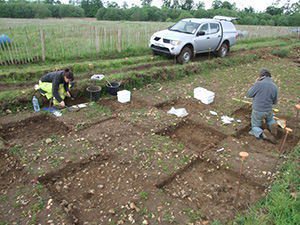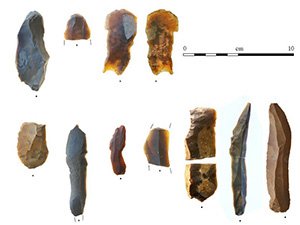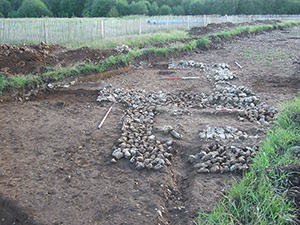 In 2009, as part of improvements to water infrastructure by Sutton and East Surrey Water (SES Water), Surrey County Archaeological Unit (SCAU) undertook excavations in a field near Fetcham Millpond, revealing a remarkable and complex archaeological landscape spanning from the Late Upper Palaeolithic through to the early Saxon period.
In 2009, as part of improvements to water infrastructure by Sutton and East Surrey Water (SES Water), Surrey County Archaeological Unit (SCAU) undertook excavations in a field near Fetcham Millpond, revealing a remarkable and complex archaeological landscape spanning from the Late Upper Palaeolithic through to the early Saxon period.
Among the most significant discoveries was a rare in situ scatter of Late Upper Palaeolithic/Early Mesolithic flintwork. The assemblage consisted of more than 500 struck flints, indicating on-site knapping and tool manufacture. These flints were concentrated in two locations, suggesting the position of two people sitting next to each other making flint blades around 10,000BC. The site would have been used as a temporary hunting camp, with the River Mole providing an area rich with resources. In addition to the earlier activity, a concentration of Neolithic and Bronze Age flintwork, including a leaf arrowhead and scrapers, indicated ongoing use of the site through successive prehistoric periods.
 A further key discovery was the flint foundations of a Roman building, possibly a bathhouse. Although only a portion of the structure was exposed, the discovery of flue tiles strongly suggests the presence of heated rooms. The villa’s location - within the river valley rather than on elevated ground - makes it unusual among known Surrey Roman villa sites, adding significant value to our understanding of Roman settlement in the region.
A further key discovery was the flint foundations of a Roman building, possibly a bathhouse. Although only a portion of the structure was exposed, the discovery of flue tiles strongly suggests the presence of heated rooms. The villa’s location - within the river valley rather than on elevated ground - makes it unusual among known Surrey Roman villa sites, adding significant value to our understanding of Roman settlement in the region.
Early Saxon pottery and a dated posthole also indicate later use of the site. While modest in quantity, these finds raise the possibility of continuity from the late Roman period into the early medieval era - a rare phenomenon in Surrey. In 2010, a nearby excavation also undertaken by SCAU uncovered 18 burials from the 7th century at Hawk’s Hill. The burials would have formed part of a larger cemetery, but the proximity to Fetcham Millpond may indicate that the associated settlement lay nearby, potentially on or around the site of the Roman villa. It is common for early Saxon cemeteries to be located at some distance from their corresponding settlements, and in many cases the location of those settlements remains unidentified.
 The discovery of early Saxon pottery and a dated posthole at Fetcham Mill Pond suggests that this site could represent the elusive domestic focus connected to the Hawk’s Hill cemetery. If confirmed, this would offer rare evidence in Surrey for continuity of occupation from the Roman to the early medieval period, as well as an important link between burial and settlement landscapes during the early Saxon era.
The discovery of early Saxon pottery and a dated posthole at Fetcham Mill Pond suggests that this site could represent the elusive domestic focus connected to the Hawk’s Hill cemetery. If confirmed, this would offer rare evidence in Surrey for continuity of occupation from the Roman to the early medieval period, as well as an important link between burial and settlement landscapes during the early Saxon era.
The Fetcham excavations demonstrate the extraordinary depth and diversity of Surrey’s past and highlight how infrastructure projects, when combined with archaeological expertise, can reveal stories that might otherwise remain buried.
Discover the full story of these excavations in our publication, 'Late upper Palaeolithic/Early Mesolithic, Roman and Saxon discoveries at Fetcham near Leatherhead', which can be purchased from the Surrey Heritage online shop.
Communities at the River: The Fetcham Springs Archaeology Project
The tantalising glimpse into the lives of previous Fetcham inhabitants provided by these excavations has prompted SES Water and SCAU to develop a new community archaeology project focusing on the site next to Fetcham Mill Ponds, Communities at the River: The Fetcham Springs Archaeology Project. The National Lottery Heritage Funded project will expand our understanding of the site over five years, engaging the local community with their heritage. Volunteers, supervised by professional archaeologists from SCAU, will explore the extent and significance of the remains, develop new skills, and connect with others in the area. Training in archaeological techniques and finds processing will compliment open days, displays, workshops, and immersive family sessions, raising awareness of this internationally significant site and promoting its preservation. Local schools and community groups will participate, ensuring a multi-generational project.
Recognised by the Wildlife Trust’s Biodiversity Benchmark, and with SES Water’s active support, this project will integrate archaeology and nature conservation, safeguarding cultural and natural heritage sustainably. For details of the project or how to get involved, please email education.scau@surreycc.gov.uk or visit the SCAU Facebook page.
Images
Select image to view a larger version.
- Late Upper Palaeolithic and Early Mesolithic flint scatter under excavation
- Selection of Late Upper Palaeolithic and Early Mesolithic flint tools
- Flint foundations of the Roman building

